Rate Decline Analysis for Modeling Volume Fractured Well Production in Naturally Fractured Reservoirs
Abstract
:1. Introduction
2. Analytical Solution to Mathematical Model
- (1)
- All the hydraulic fractures, with the same properties, fully penetrate the formation, and the reservoir is closed at the external boundary of side and bounded by upper and lower impermeable formation.
- (2)
- Flow in the reservoir is considered to be a single-phase flow with slightly compressible fluid of constant viscosity and volume factor.
- (3)
- The joint fracture network constituted the main flow channel in the composite system, and fluid flow in the reservoir is laminar and isothermal. In the inner region, fluid flows into the wellbore only through hydraulic fractures and the matrices of this region have no contribution to the flow; in the outer region, fluid first flows from the matrices to the natural fractures and then directly flows into the hydraulic fractures of the inner region.
- (4)
- A vertical well intercepted by a finite number of hydraulic fractures is located at the center of the composite reservoir. No wellbore storage effect and skin effect is considered.
3. Verification of the Analytical Solution
4. Results and Discussion
4.1. Comparison with a Model not Having Volume Fracturing
4.2. Parameter Influence on Transient and Cumulative Rate Curves
4.2.1. Interregional Diffusivity Ratio α and Interregional Conductivity Ratio β
4.2.2. Storativity Ratio ω and Interporosity Coefficient λ
4.2.3. Dimensionless Reservoir Radius reD
4.3. Flow Regime Recognition on Blasingame Type Curves
- (1)
- Dimensionless rate integral function: qDdi
- (2)
- Dimensionless rate integral derivative function: qDdid
4.4. Sensitivity Analysis of New Blasingame Type Curves
4.4.1. Interregional Diffusivity Ratio
4.4.2. Interregional Conductivity Ratio β
4.4.3. Storativity Ratio ω
4.4.4. Interporosity Coefficient λ
4.4.5. Dimensionless Reservoir Radius reD
5. Conclusions
- Compared with the model not having volume fracturing, this stimulation technique mainly contributes to the early-flow period’s production.
- Three characteristic decline stages and two stable production periods may be observed on the transient rate curves. In the early-flow period, the transient rate at the same wellbore pressure increases as interregional diffusivity ratio increases or interregional conductivity ratio decreases. In the middle- and late-flow periods, the shape of the traditional rate curves depends on naturally fractured medium and boundary condition.
- New Blasingame type curves for volume fractured wells in naturally fractured reservoirs are established and can be used to deal with the problem of both variable rate and variable wellbore pressure. Five flow regimes may be observed on the new Blasingame type curves: linear flow regime, transition flow regime, radial flow regime, inter-porosity flow regime, and pseudo-steady flow regime. The shape and position of type curves in linear- and transition-flow regimes are predominantly determined by interregional diffusivity ratio and interregional conductivity ratio.
- New Blasingame type curves have more salient features and better normalizations than the traditional rate curves and are convenient for us to conduct well testing analysis. Sensitivity analysis indicates that these new type curves for varied interregional diffusivity ratio, interregional conductivity ratio, interporosity coefficient and dimensionless reservoir radius, except storativity ratio, will normalize in the late-flow period.
Acknowledgments
Author Contributions
Conflicts of Interest
Nomenclature
| k | permeability, m2 |
| h | formation thickness, m |
| μ | fluid viscosity, Pa·s |
| p | pressure, Pa |
| r | radial distance, m |
| rf | half length of artificial fracture, m |
| b | aperture of artificial fracture, m |
| t | time variable, s |
| porosity, fraction | |
| ct | compressibility factor, Pa−1 |
| q | total rate at the wellbore, m3/s |
| B | volume factor, m3/m3 |
| γ | shape factor, dimensionless |
| η | fluid transmissivity factor, Pa·m2/(Pa·s) |
| n | number of artificial fractures, dimensionless |
| π | 3.1415926…… |
| rD | dimensionless radius |
| reD | dimensionless drainage radius |
| rwD | dimensionless wellbore radius |
| tD | dimensionless time |
| tDd | dimensionless decline time |
| bDpss | dimensionless pseudo-steady constant |
| p1D | dimensionless pressure in the inner region |
| pwD | dimensionless wellbore pressure |
| p2fD | dimensionless pressure of natural fracture system |
| p2mD | dimensionless pressure of matrix system |
| pwD,pss | dimensionless wellbore pressure in pseudo-steady flow regime |
| qwD | dimensionless transient rate |
| qcD | dimensionless cumulative rate |
| qDd | dimensionless decline rate |
| qDdi | dimensionless rate integral |
| qDdid | dimensionless rate integral derivative |
| s | time variable in Laplace domain |
| x1 | corresponding coefficient in Laplace domain |
| x2 | corresponding coefficient in Laplace domain |
| dimensionless pressure p1D in Laplace domain | |
| dimensionless wellbore pressure pwD in Laplace domain | |
| dimensionless pressure p2fD in Laplace domain | |
| dimensionless transient rate qwD in Laplace domain | |
| dimensionless cumulative rate qcD in Laplace domain |
| α | interregional diffusivity ratio |
| β | interregional conductivity ratio |
| ω | fracture-matrix storativity ratio |
| λ | fracture-matrix interporosity coefficient |
| I0(x) | modified Bessel function (1st kind, zero order) |
| I1(x) | modified Bessel function (1st kind, first order) |
| K0(x) | modified Bessel function (2nd kind, zero order) |
| K1(x) | modified Bessel function (2nd kind, first order) |
| D | dimensionless |
| w | wellbore |
| e | reservoir external boundary |
| 1 | inner region |
| 2f | natural fracture in the outer region |
| 2m | matrix in the outer region |
| i | initial or ordinal |
Appendix A. Establishment of Mathematical Model
Appendix A.1. Flow in the Inner Region
Appendix A.2. Flow in the Outer Region
Appendix A.3. Interface Conditions
References
- Wu, Q.; Xu, Y.; Wang, X.; Wang, T.; Zhang, S. Volume fracturing technology of unconventional reservoirs: Connotation, design optimization and implementation. Petrol. Explor. Dev. 2012, 39, 377–384. [Google Scholar] [CrossRef]
- Zhou, D.; Zheng, P.; He, P.; Peng, J. Hydraulic fracture propagation direction during volume fracturing in unconventional reservoirs. J. Pet. Sci. Eng. 2016, 141, 82–89. [Google Scholar] [CrossRef]
- Arps, J.J. Analysis of decline curves. Trans. AIME 1945, 160, 228–247. [Google Scholar] [CrossRef]
- Fetkovich, M.J. Decline curve analysis using type curves. J. Pet. Technol. 1980, 32, 1065–1077. [Google Scholar] [CrossRef]
- Blasingame, T.A.; Johnston, J.L.; Lee, W.J. Type-curve analysis using the pressure integral method. In Proceedings of the SPE California Regional Meeting, Bakersfield, CA, USA, 5–7 April 1989. Paper No. SPE-18799. [Google Scholar] [CrossRef]
- Blasingame, T.A.; McCray, T.L.; Lee, W.J. Decline curve analysis for variable pressure drop/variable flowrate systems. In Proceedings of the SPE Gas Technology Symposium, Houston, TX, USA, 22–24 January 1991. Paper No. SPE-21513. [Google Scholar] [CrossRef]
- Agarwal, R.G.; Gardner, D.C.; Kleinsteiber, S.W.; Fussell, D.D. Analyzing well production data using combined type curve and decline curve analysis concepts. In Proceedings of the SPE Annual Technical Conference and Exhibition, New Orleans, LA, USA, 27–30 September 1998. Paper No. SPE-49222. [Google Scholar] [CrossRef]
- Hagoort, J. A simplified analytical method for estimating the productivity of a horizontal well producing at constant rate or constant pressure. J. Pet. Sci. Eng. 2009, 64, 77–87. [Google Scholar] [CrossRef]
- Lei, Z.; Cheng, S.; Li, X.; Xiao, H. A new method for prediction of productivity of fractured horizontal wells based on non-steady flow. J. Hydrodyn. Ser. B 2007, 19, 494–500. [Google Scholar] [CrossRef]
- Pratikno, H.; Rushing, J.A.; Blasingame, T.A. Decline curve analysis using type curves-fractured wells. In Proceedings of the SPE Annual Technical Conference and Exhibition, Denver, CO, USA, 5–8 October 2003. Paper No. SPE-84287. [Google Scholar] [CrossRef]
- Tian, J.; Tong, D. The flow analysis of fluids in fractal reservoir with the fractional derivative. J. Hydrodyn. Ser. B 2006, 18, 287–293. [Google Scholar] [CrossRef]
- Tiab, D.; Lu, J.; Nguyen, H.; Owayed, J. Evaluation of fracture asymmetry of finite-conductivity fractured wells. ASME J. Energy Resour. Technol. 2010, 132, 012901. [Google Scholar] [CrossRef]
- Gringarten, A.C.; Ramey, H.J., Jr.; Raghavan, R. Applied pressure analysis for fractured wells. J. Pet. Technol. 1975, 27, 887–892. [Google Scholar] [CrossRef]
- Cinco-Ley, H.; Samaniego, V.F.; Dominguez, A.N. Transient pressure behavior for a well with a finite-conductivity vertical fracture. SPE J. 1978, 18, 253–264. [Google Scholar] [CrossRef]
- Wang, J.; Wang, X.; Xu, W.; Lu, C.; Dong, W.; Zhang, C. Productivity analysis of volume fractured vertical well model in tight oil reservoirs. Math. Probl. Eng. 2017, 2017, 9589321. [Google Scholar] [CrossRef]
- Wang, L.; Wang, X.; Ding, X.; Zhang, L.; Li, C. Rate decline curves analysis of a vertical fractured well with fracture face damage. J. Energ. Resour. ASME 2012, 134, 032803. [Google Scholar] [CrossRef]
- Tinsley, J.M.; Williams, J.R., Jr.; Tiner, R.L.; Malone, W.T. Vertical fracture height - its effect on steady-state production increase. J. Pet. Technol. 1969, 21, 633–638. [Google Scholar] [CrossRef]
- Raghavan, R.; Cady, G.V.; Ramey, H.J., Jr. Well-test analysis for vertically fractured wells. J. Pet. Technol. 1972, 24, 1014–1020. [Google Scholar] [CrossRef]
- Blanton, T.L. Propagation of hydraulically and dynamically induced fractures in naturally fractured reservoirs. In Proceedings of the SPE Unconventional Gas Technology Symposium, Louisville, KY, USA, 18–21 May 1986. Paper No. SPE-15261. [Google Scholar] [CrossRef]
- Daneshy, A.A. Off-balance growth: A new concept in hydraulic fracturing. J. Pet. Technol. 2003, 55, 78–85. [Google Scholar] [CrossRef]
- Fisher, M.K.; Wright, C.A.; Davidson, B.M.; Goodwin, A.K.; Fielder, E.O.; Buckler, W.S.; Steinsberger, N.P. Integrating fracture mapping technologies to optimize stimulations in the Barnett Shale. In Proceedings of the SPE Annual Technical Conference and Exhibition, San Antonio, TX, USA, 29 September–2 October 2002. Paper No. SPE-77441. [Google Scholar] [CrossRef]
- Mayerhofer, M.J.; Lolon, E.P.; Youngblood, J.E.; Heinze, J.R. Integration of microseismic-fracture-mapping results with numerical fracture network production modeling in the Barnett Shale. In Proceedings of the SPE Annual Technical Conference and Exhibition, San Antonio, TX, USA, 24–27 September 2006. Paper No. SPE-102103. [Google Scholar] [CrossRef]
- Murphy, H.D.; Fehler, M.C. Hydraulic fracturing of jointed formations. In Proceedings of the International Meeting on Petroleum Engineering, Beijing, China, 17–20 March 1986. Paper No. SPE-14088. [Google Scholar] [CrossRef]
- Zhu, X.; Gibson, J.; Ravindran, N.; Zinno, R.; Sixta, D. Seismic imaging of hydraulic fractures in Carthage tight sands: A pilot study. Lead. Edge 1996, 15, 218–224. [Google Scholar] [CrossRef]
- Germanovich, L.N.; Astakhov, D.K.; Mayerhofer, M.J.; Shlyapobersky, J.; Ring, L.M. Hydraulic fracture with multiple segments I. Observations and model formulation. Int. J. Rock Mech. Min. Sci. 1997, 34, 97. [Google Scholar] [CrossRef]
- Mahrer, K.D.; Aud, W.W.; Hansen, J.T. Far-field hydraulic fracture geometry: A changing paradigm. In Proceedings of the SPE Annual Technical Conference and Exhibition, Denver, CO, USA, 6–9 October 1996. Paper No. SPE-36441. [Google Scholar] [CrossRef]
- Olarewaju, J.S.; Lee, W.J. A comprehensive application of a composite reservoir model to pressure transient analysis. In Proceedings of the SPE California Regional Meeting, Ventura, CA, USA, 8–10 April 1987. Paper No. SPE-16345. [Google Scholar] [CrossRef]
- Restrepo, D.P. Pressure Behavior of a System Containing Multiple vertical Fractures. Ph.D. Thesis, University of Oklahoma, Norman, OK, USA, 2008. [Google Scholar]
- Al-Salem, K.M.; Ali, M.A.M.; Lin, C. Tight oil reservoir development feasibility study using finite difference simulation and streamlines. In Proceedings of the SPE Saudi Arabia Section Technical Symposium, Khobar, Saudi Arabia, 9–11 May 2009. Paper No. SPE-126099. [Google Scholar] [CrossRef]
- Harikesavanallur, A.K.; Deimbacher, F.; Crick, M.; Zhang, X.; Forster, P.G. Volumetric fracture modeling approach (VFMA): Incorporating microseismic data in the simulation of shale gas reservoirs. In Proceedings of the SPE Annual Technical Conference and Exhibition, Florence, Italy, 19–22 September 2010. Paper No. SPE-134683. [Google Scholar] [CrossRef]
- Liu, X.; Zhao, G. A fractal wormhole model for cold heavy oil production. J. Can. Petrol. Technol. 2005, 44, 31–36. [Google Scholar] [CrossRef]
- Liu, X.; Zhao, G.; Jin, Y. Coupled reservoir/wormholes model for cold heavy oil production wells. J. Pet. Sci. Eng. 2006, 50, 258–268. [Google Scholar] [CrossRef]
- Xiao, L.; Zhao, G. A novel approach for determining wormhole coverage in CHOP wells. In Proceedings of the SPE Heavy Oil Conference Canada, Calgary, AB, Canada, 12–14 June 2012. Paper No. SPE-157935. [Google Scholar] [CrossRef]
- Warren, J.E.; Root, P.J. The behavior of naturally fractured reservoirs. SPE J. 1963, 3, 245–255. [Google Scholar] [CrossRef]
- Van Everdingen, A.F.; Hurst, W. The application of the Laplace transform to flow problems in reservoirs. Trans. AIME 1949, 186, 305–324. [Google Scholar]
- Stehfest, H. Algorithm 368: Numerical inversion of Laplace transforms. Commun. ACM 1970, 13, 47–49. [Google Scholar] [CrossRef]
- Chiang, C.P.; Kennedy, W.A. Numerical simulation of pressure behavior in a fractured reservoir. In Proceedings of the Fall Meeting of the Society of Petroleum Engineers of AIME, Houston, TX, USA, 4–7 October 1970. Paper No. SPE-3067. [Google Scholar] [CrossRef]
- Abramowitz, M.; Stegun, I.A. Handbook of Mathematical Functions; Dover Publications Inc.: New York, NY, USA, 1972. [Google Scholar]
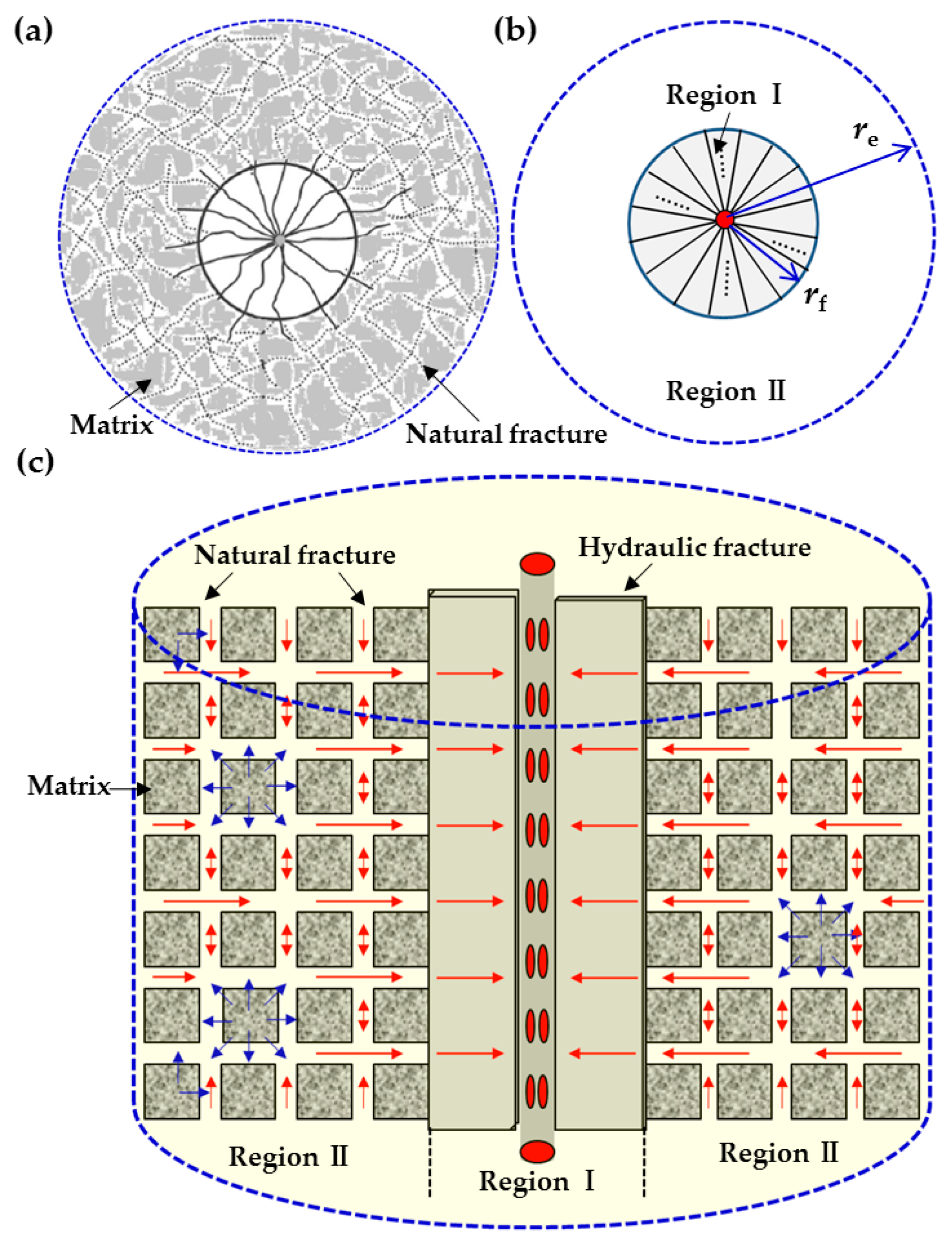
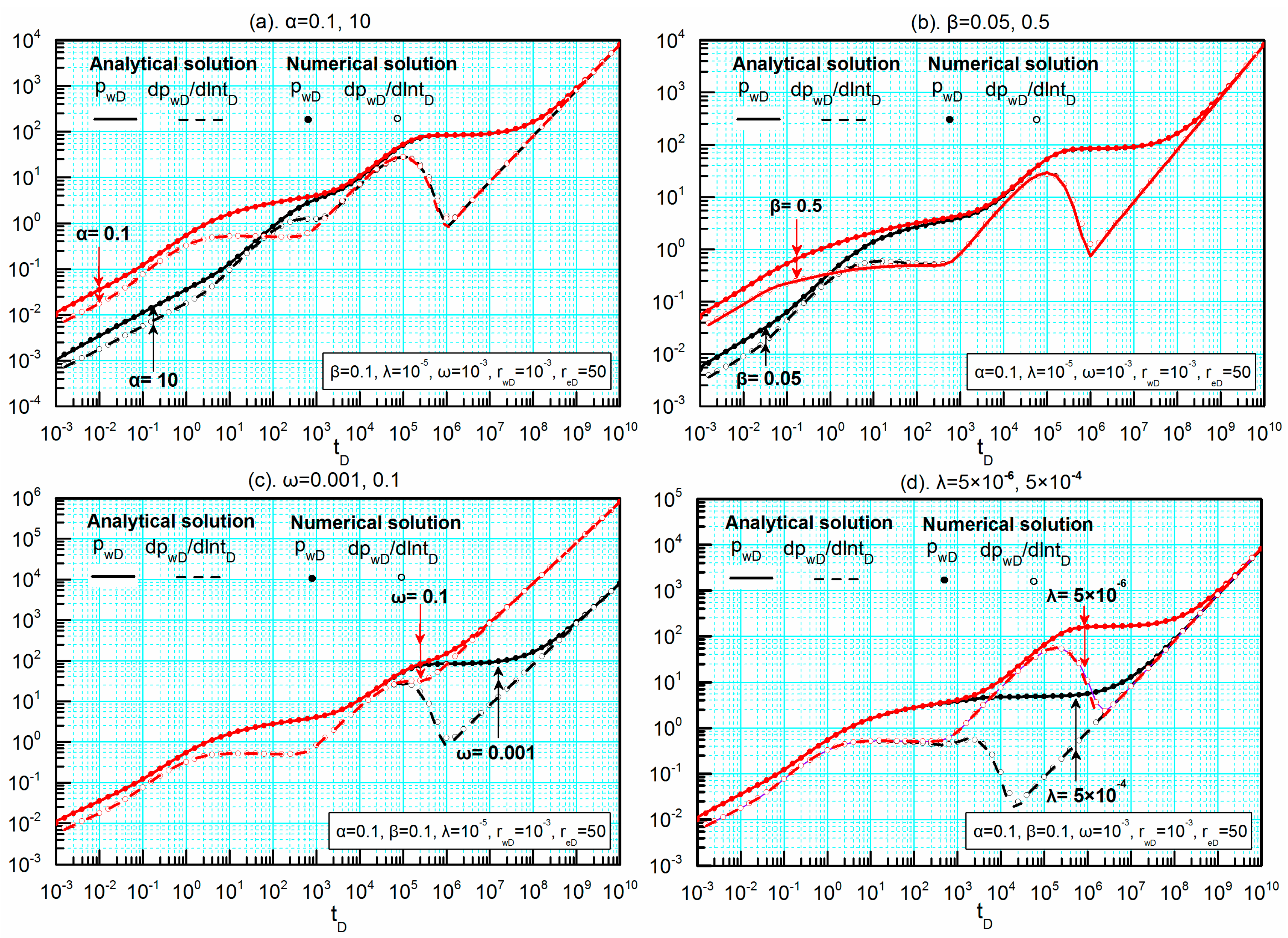
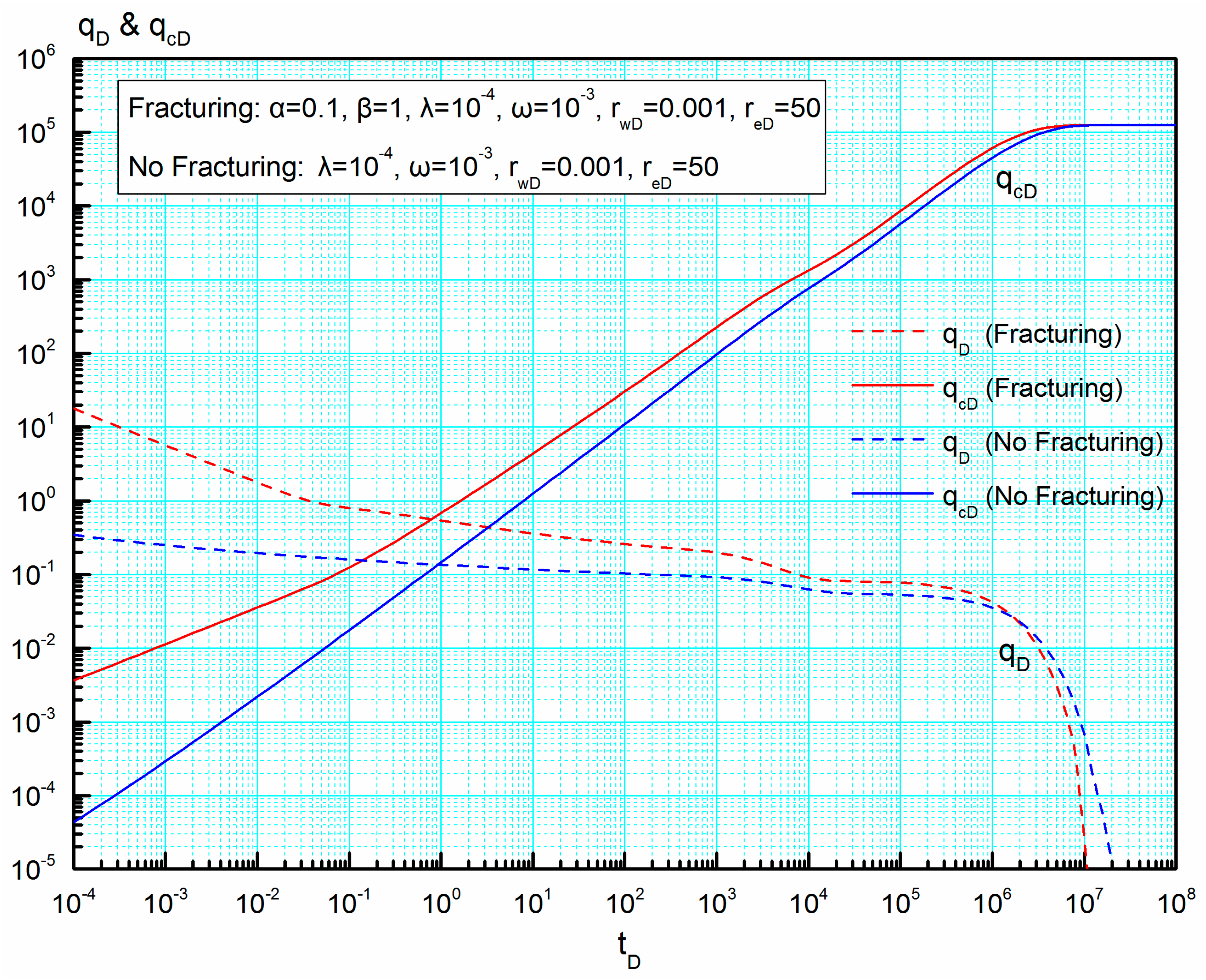
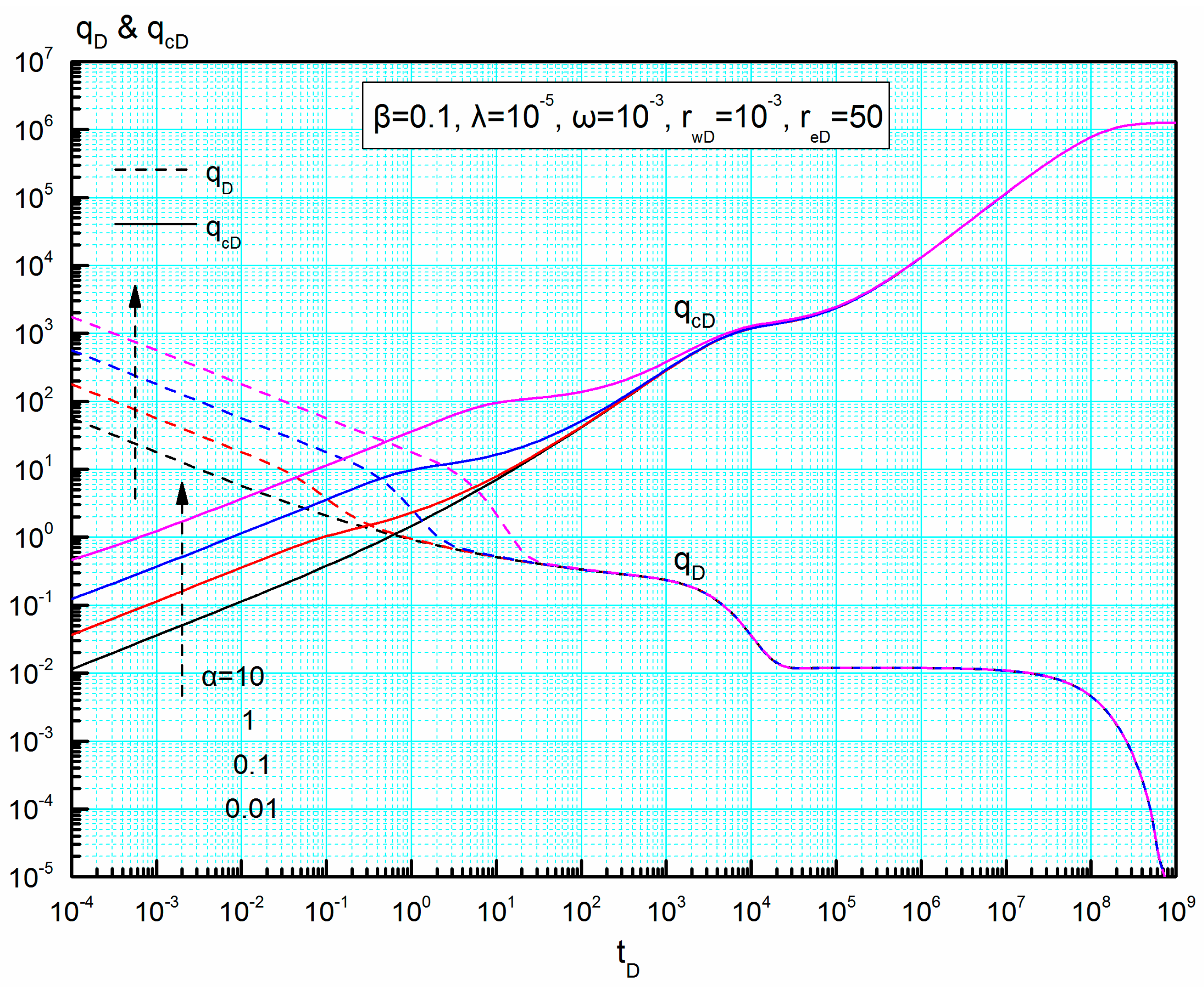
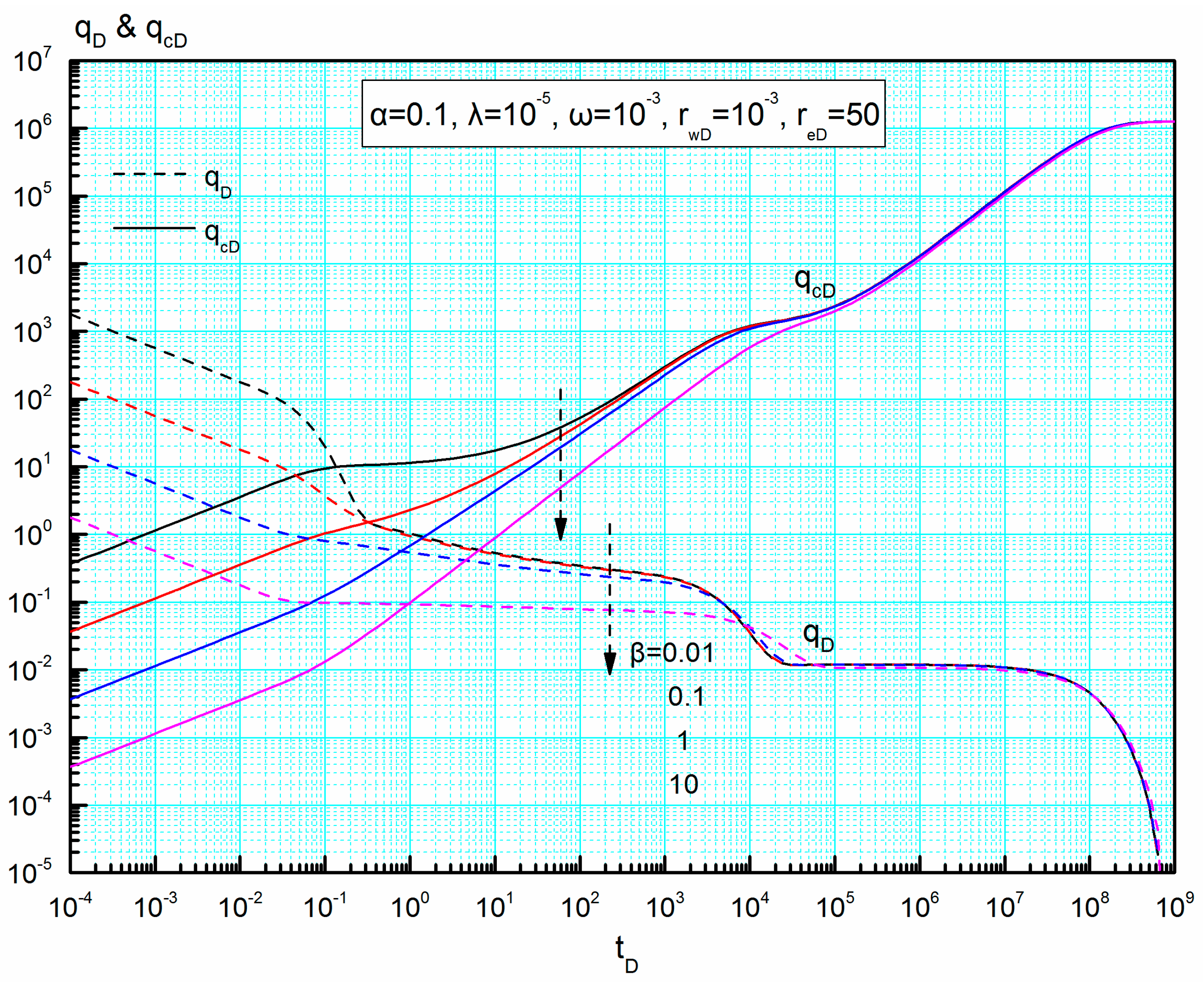
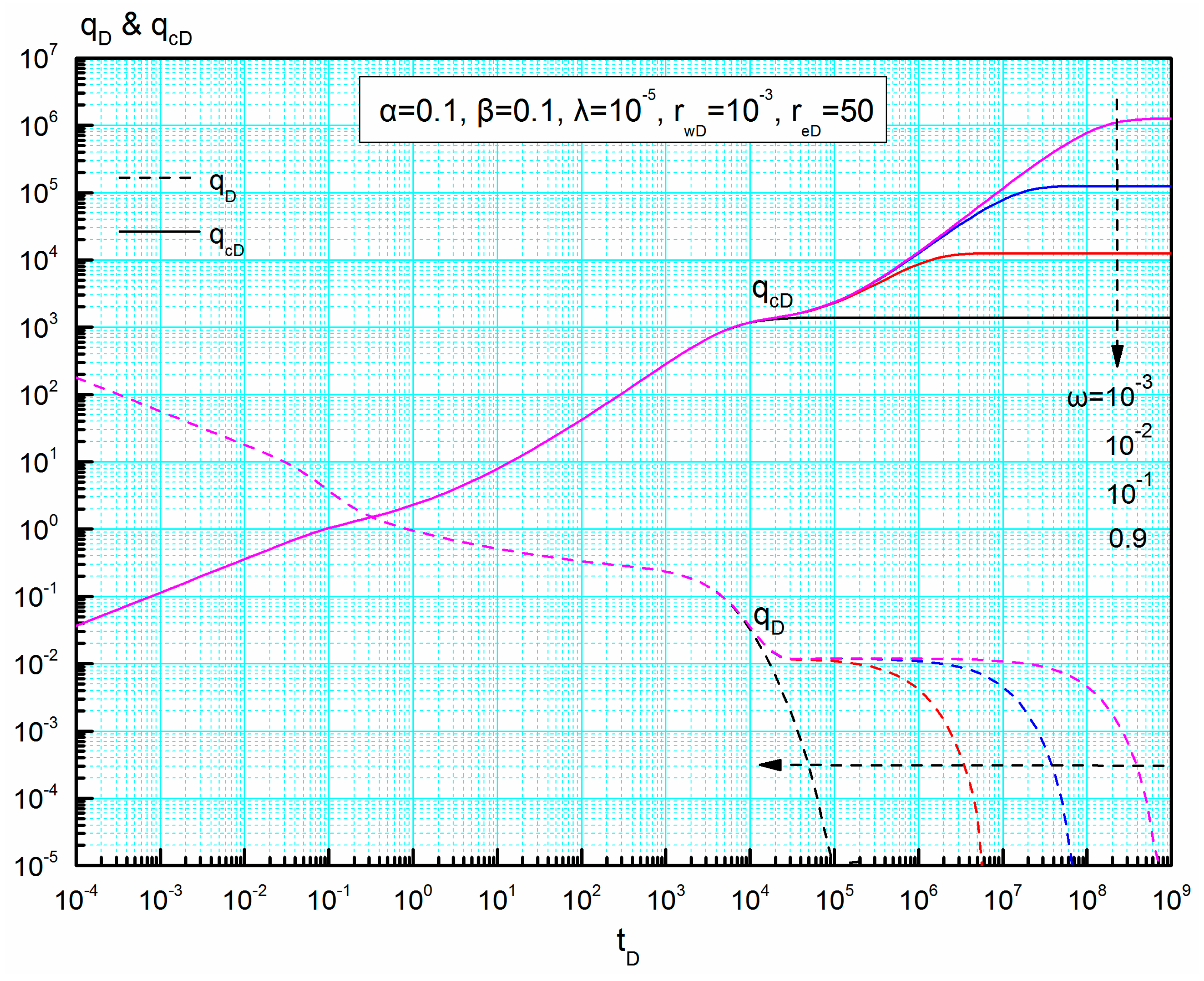
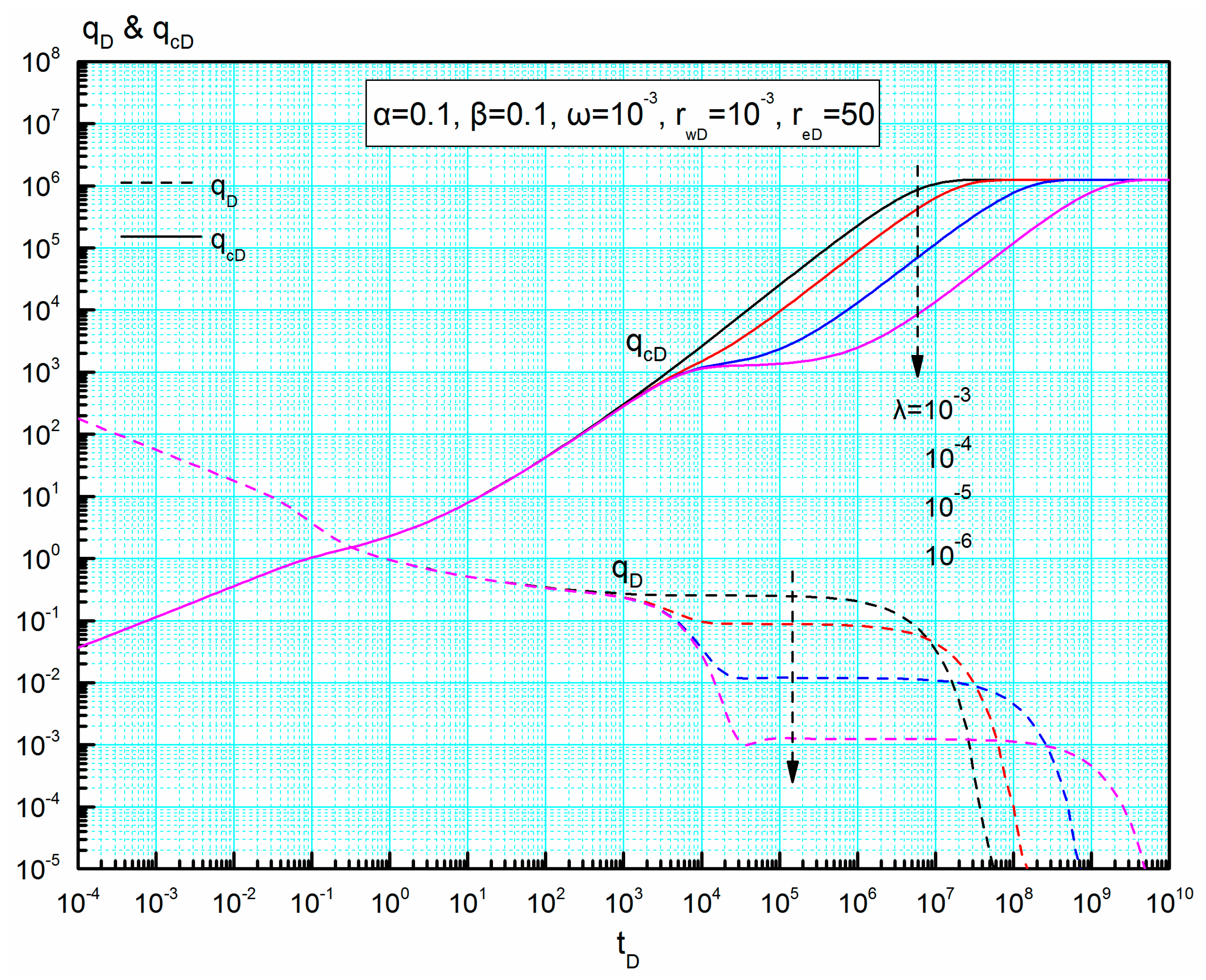
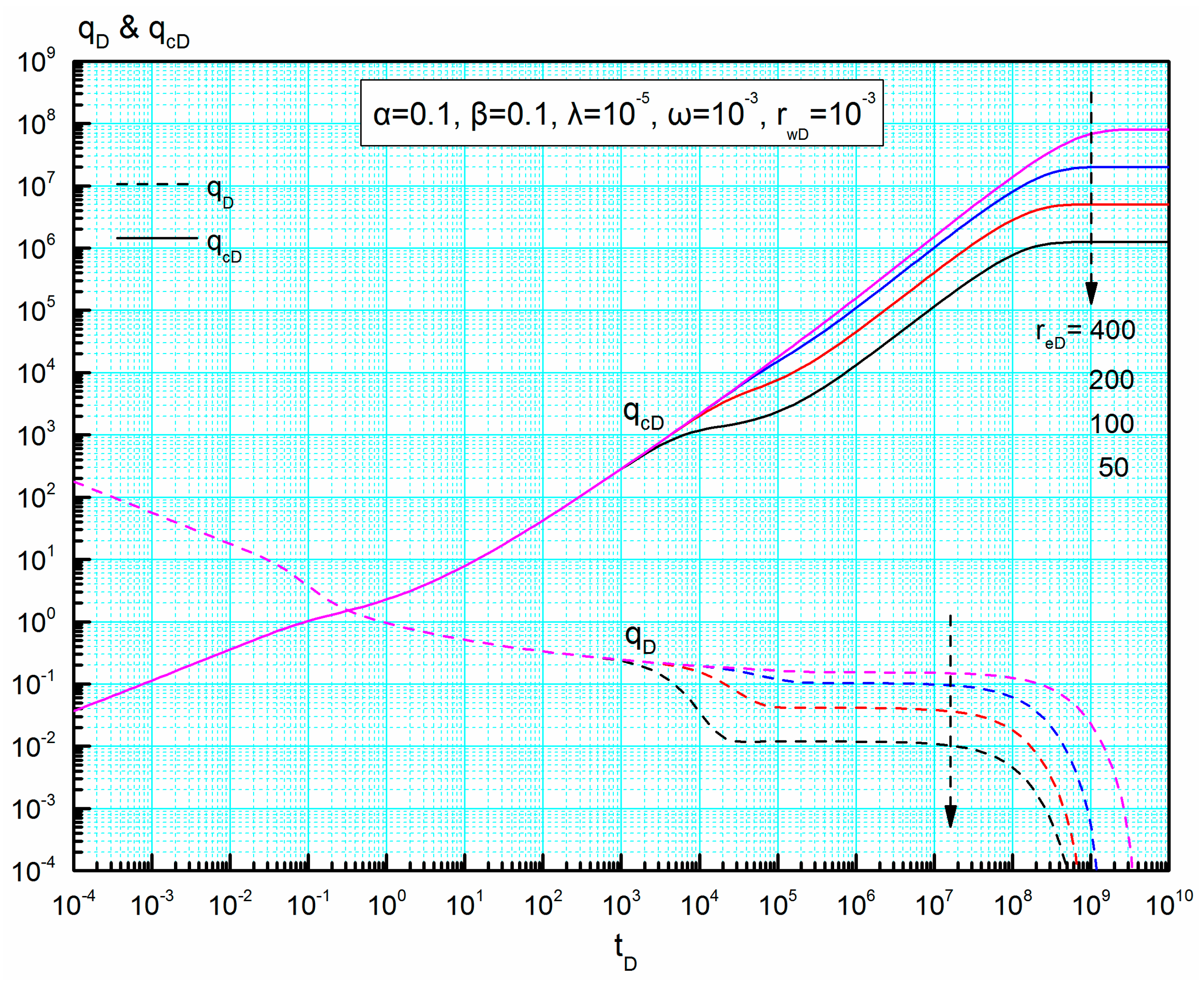
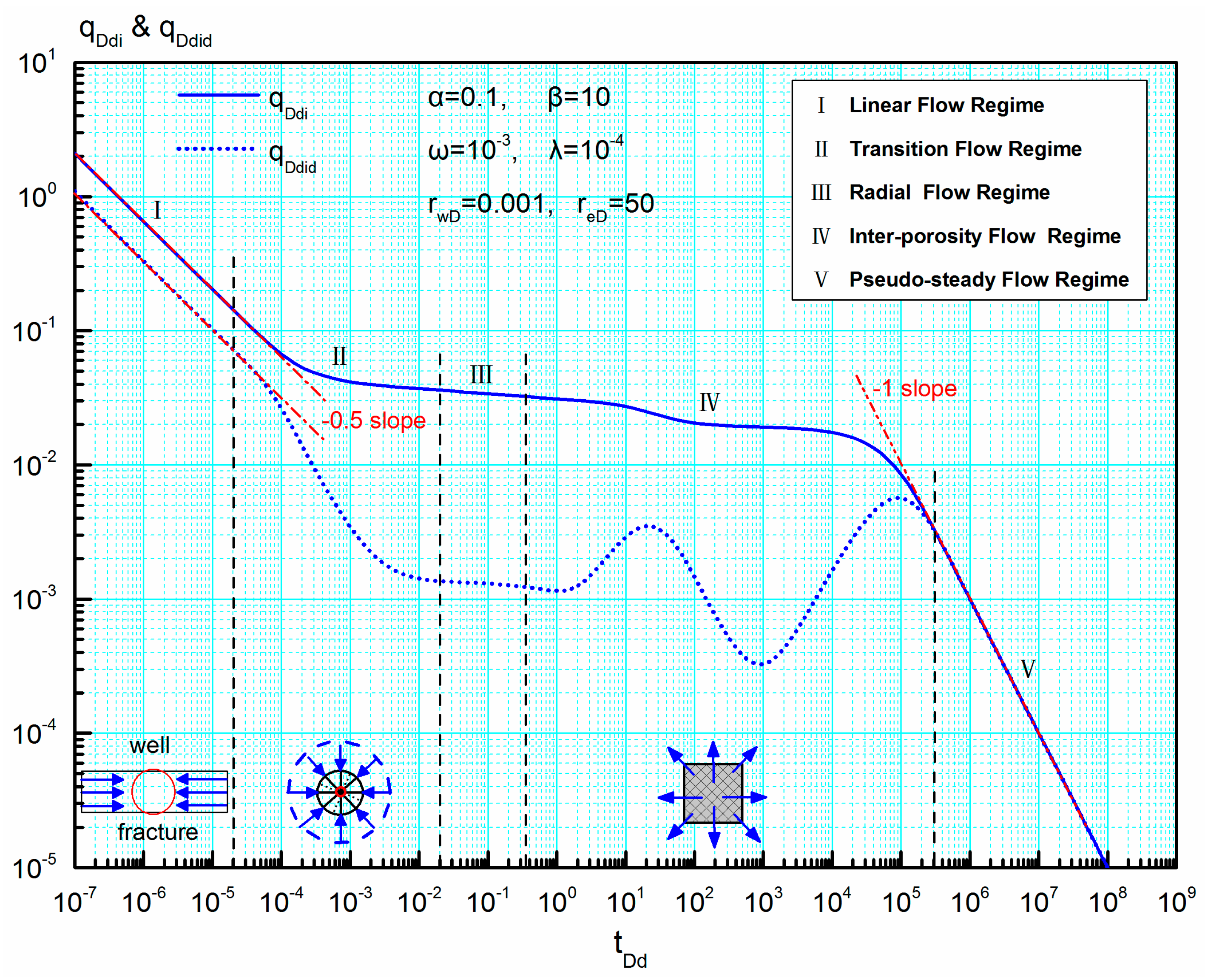

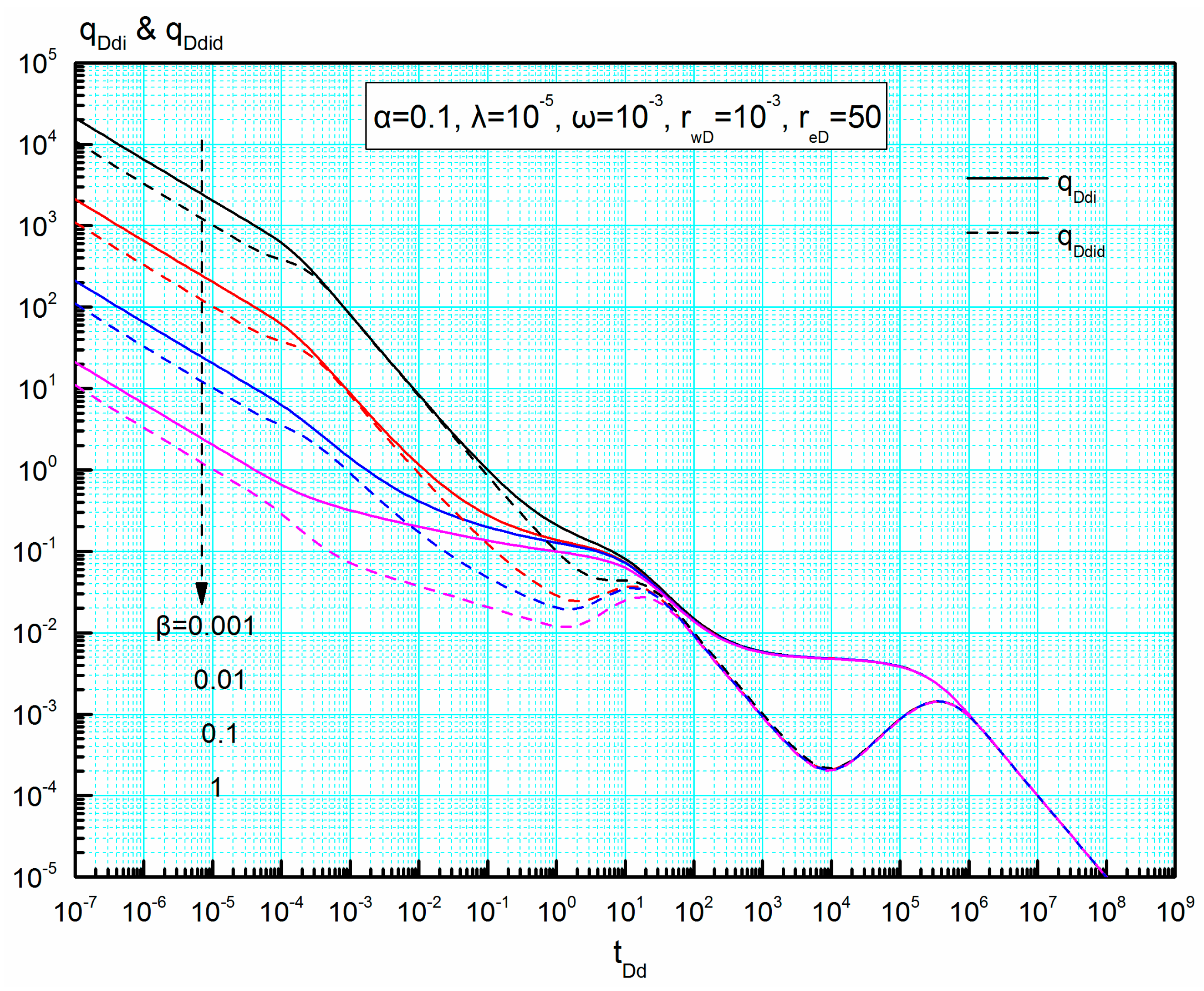
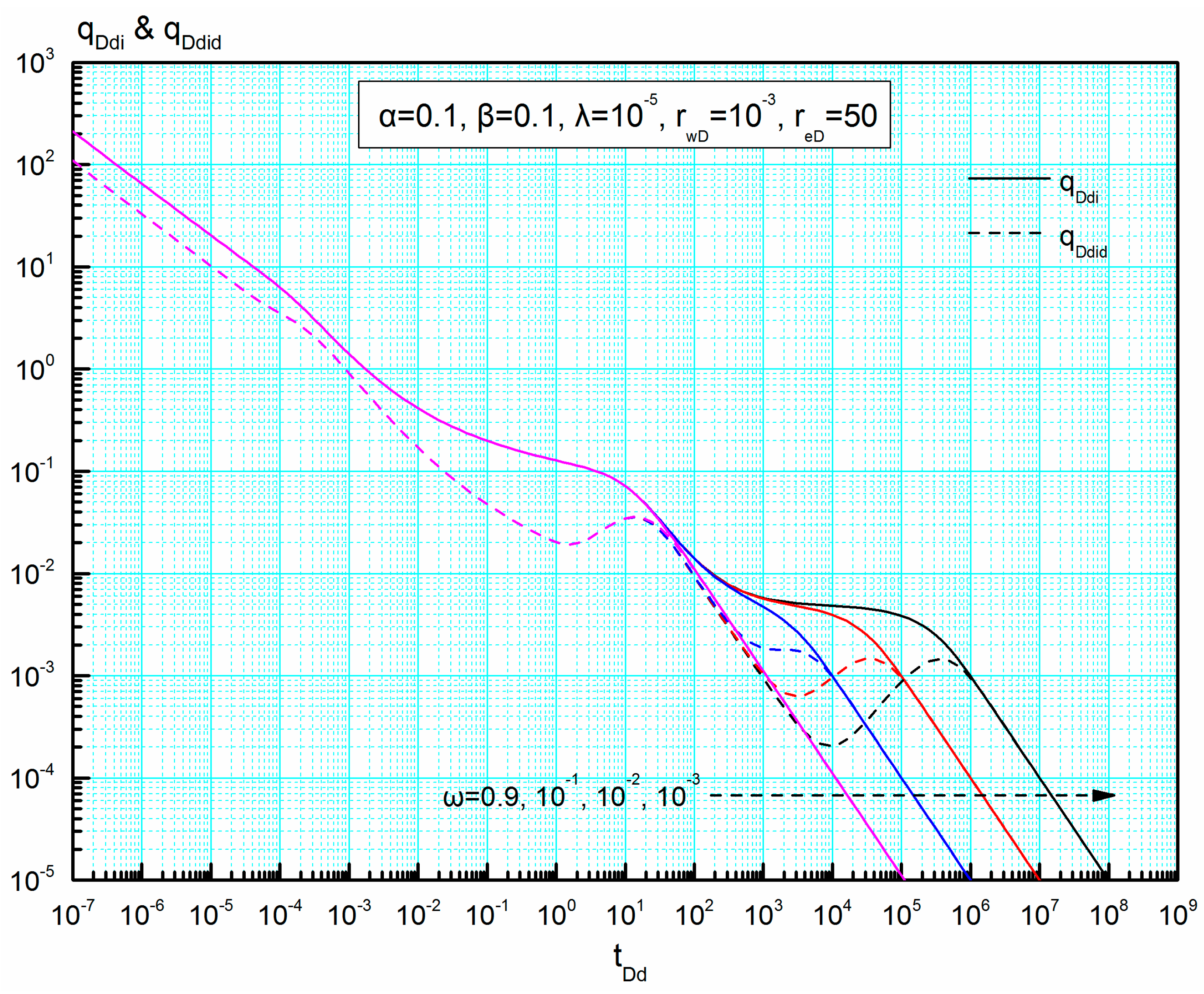
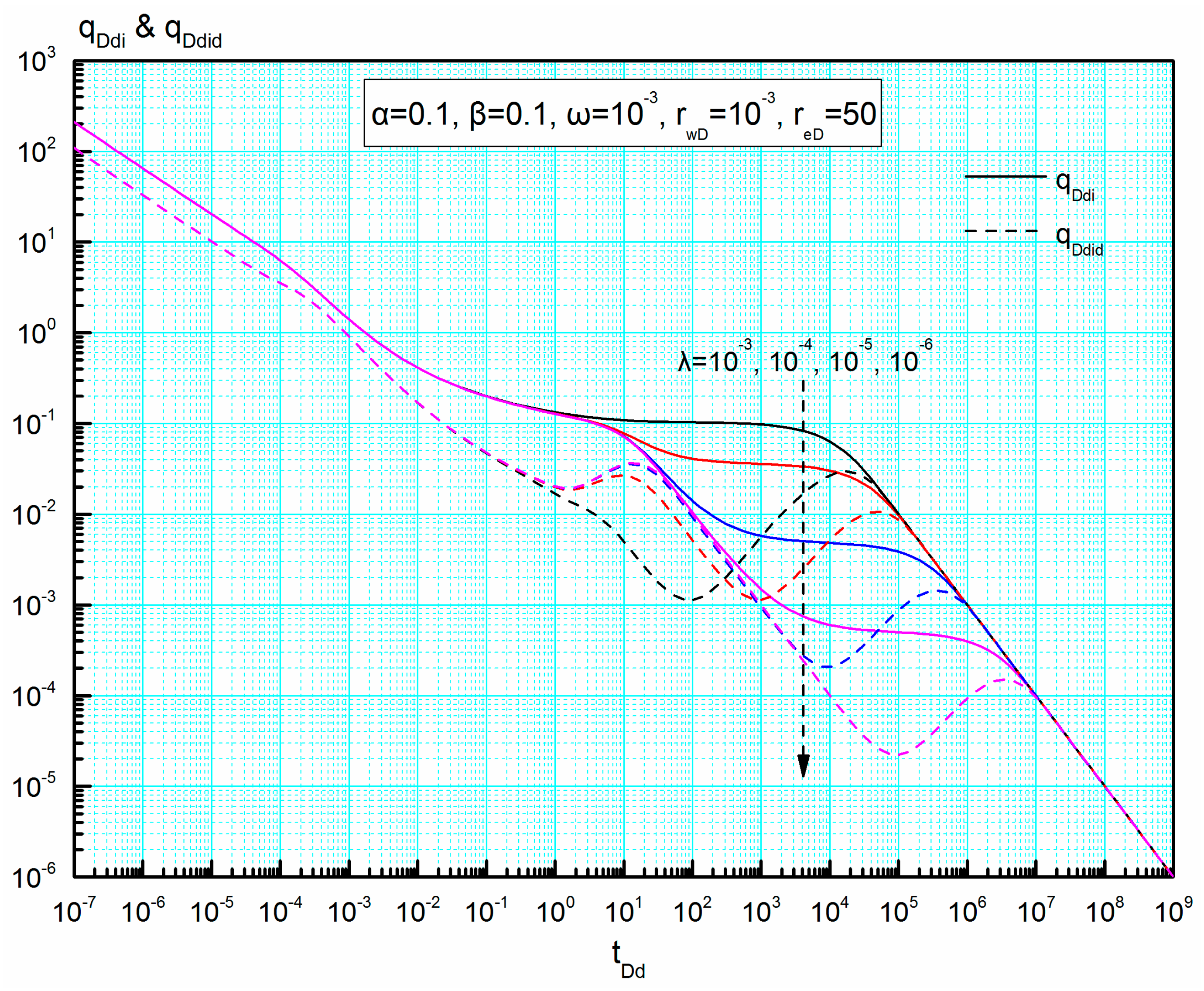
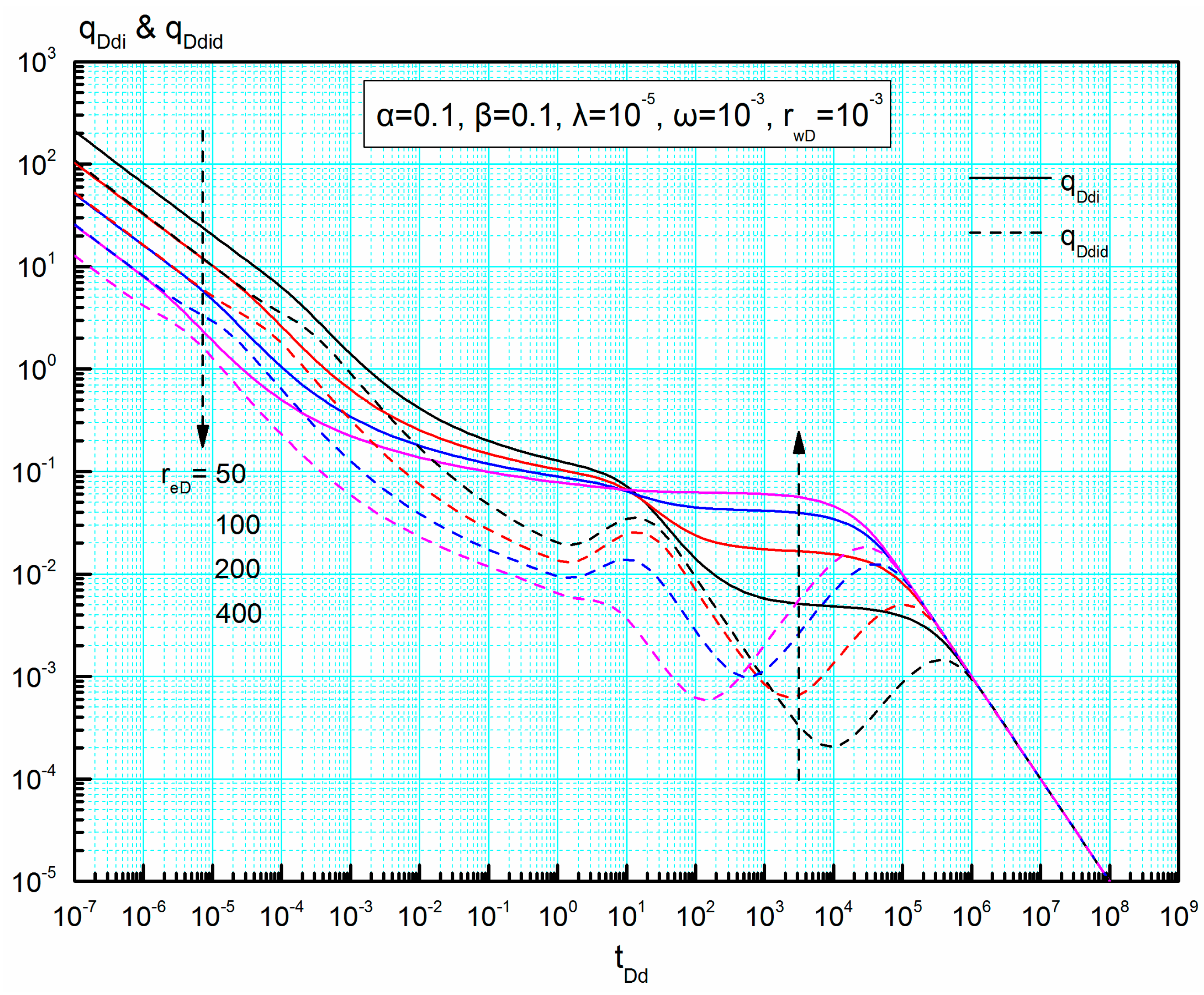
© 2018 by the authors. Licensee MDPI, Basel, Switzerland. This article is an open access article distributed under the terms and conditions of the Creative Commons Attribution (CC BY) license (http://creativecommons.org/licenses/by/4.0/).
Share and Cite
Wang, M.; Fan, Z.; Xing, G.; Zhao, W.; Song, H.; Su, P. Rate Decline Analysis for Modeling Volume Fractured Well Production in Naturally Fractured Reservoirs. Energies 2018, 11, 43. https://doi.org/10.3390/en11010043
Wang M, Fan Z, Xing G, Zhao W, Song H, Su P. Rate Decline Analysis for Modeling Volume Fractured Well Production in Naturally Fractured Reservoirs. Energies. 2018; 11(1):43. https://doi.org/10.3390/en11010043
Chicago/Turabian StyleWang, Mingxian, Zifei Fan, Guoqiang Xing, Wenqi Zhao, Heng Song, and Penghui Su. 2018. "Rate Decline Analysis for Modeling Volume Fractured Well Production in Naturally Fractured Reservoirs" Energies 11, no. 1: 43. https://doi.org/10.3390/en11010043
APA StyleWang, M., Fan, Z., Xing, G., Zhao, W., Song, H., & Su, P. (2018). Rate Decline Analysis for Modeling Volume Fractured Well Production in Naturally Fractured Reservoirs. Energies, 11(1), 43. https://doi.org/10.3390/en11010043




